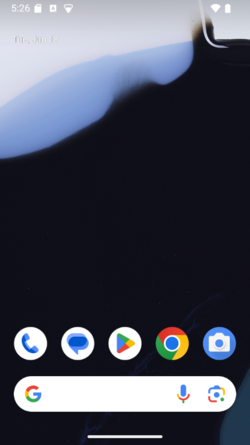Android
| Distribution of Linux | |
 | |
 Android 15 (emulator image) home screen | |
| Architecture | arm64, armhf, x86_64, riscv |
|---|---|
| Release type | Fixed |
| Initial version | Android 1.x (23 September 2008) |
| Latest version | Android 15 |
| Terminal shell | toybox |
Android is an operating system based on Linux produced by Google that targets smart, portable and/or embedded devices such as phones, tablets, smartwatches, televisions, cars and other embedded systems. Android was originally developed by a company called Android Inc. Google later acquired the company in July 2005 and then made the Android SDK available in November 2007. One year later, the first version of Android was released in September 2008.
From Android 1.5 until Android 10, every major Android version had a name based on different desserts in alphabetical order. From Android 10 until 12L, the version number is used instead in official releases, while the dessert names only remain for internal codenames. Starting from Android 13, the dessert name is mentioned in the public SDK and shown in developer previews and early beta versions.
Beginning with Android 14 QPR2, Android uses a trunk stable development model. Every quarter the platform will advance to a much more recent version of the primary development branch, with incomplete/unreleased functionality being disabled through configuration (aconfig) build system flags.
In January 2020, Microsoft released the first preview of their custom Android experience meant to run on the Surface Duo, build 2020.117.2.
Timeline
The codenames are named after desserts, similar to how Ubuntu's codenames were named after animals.
| Codename(s) | Release date | Notes | |
|---|---|---|---|
| Android 1.x | Astro Boy, Bender, Petit Four, Cupcake, Donut | 23 September 2008 | HTC Dream was the first phone to be released with Android. |
| Android 2.x | Eclair, Froyo, Gingerbread | 26 October 2009 | Supported more screen resolutions. |
| Android 3.x | Honeycomb | 22 February 2011 | This version was targeted at tablets only. |
| Android 4.x | Ice Cream Sandwich, Jelly Bean, KitKat, Key Lime Pie (4.4 internal) | 18 October 2011 | First version to integrate the screenshot feature. |
| Android 5.x | Lollipop, Lemon Meringue Pie (internal) | 12 November 2014 | Introduced a new design known as Material Design. |
| Android 6.x | Marshmallow, Macadamia Nut Cookie (internal) | 29 September 2015 | First version to support USB-C and fingerprint sensors natively. |
| Android 7.x | Nougat, New York Cheesecake (internal) | 22 August 2016 |
|
| Android 8.x | Oreo, Oatmeal Cookie (internal) | 21 August 2017 | 8.0: First version to have picture-in-picture support.
8.1: First version to introduce Project Treble and Vendor Native Development Kit. |
| Android 9 | Pie, Pistachio Ice Cream (internal) | 6 August 2018 |
|
| Android 10 | Quince Tart (internal), Queen Cake (planned but scrapped public codename)[1], Q | 3 September 2019 |
|
| Android 11 | Red Velvet Cake (internal), R | 8 September 2020 |
|
| Android 12 | Snow Cone (internal), S | 4 October 2021 |
|
| Android 12L | Snow Cone 2 (internal), Sv2 | 7 March 2022 | Introduced a new optimized layout for tablets and large-screen devices.
Released as Android 12.1 for Pixel smartphones.[2] |
| Android 13 | Tiramisu | 15 August 2022 |
|
| Android 14 | Upside Down Cake | 4 October 2023 | Adds support for satellite connectivity |
| Android 15 | Vanilla Ice Cream | 3 September 2024 |
|
| Android 16 | Baklava | TBA |
References
- ↑ https://www.androidcentral.com/android-q-queen-cakes-publicly
- ↑ Android 12.1 March security patch rolling out to Google Pixel, factory images & OTAs live - 9to5Google: The factory images this morning revealed that Android 12L is officially Android 12.1, though [the version number doesn't] appear anywhere in the OS/system Settings app.